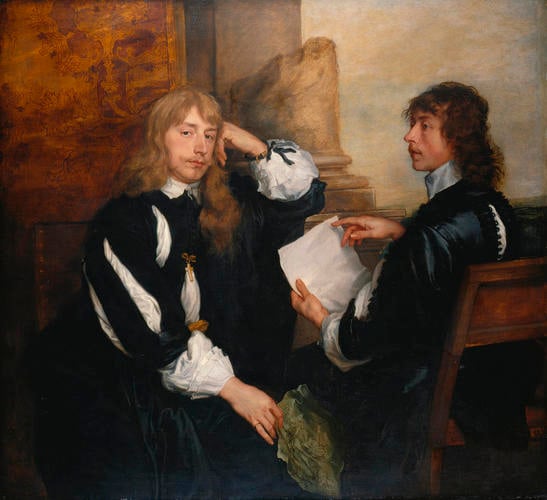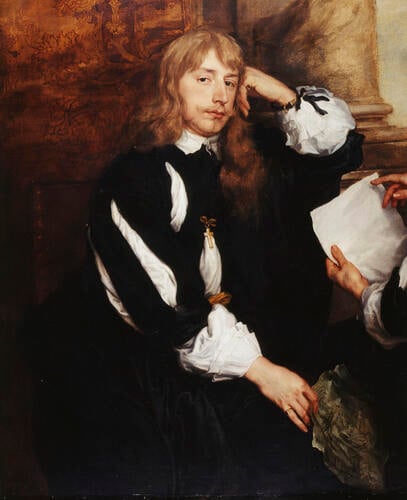-
1 of 253523 objects
Thomas Killigrew and William, Lord Crofts (?) 1638
Oil on canvas | 132.9 x 144.1 cm (support, canvas/panel/stretcher external) | RCIN 407426
-
Van Dyck's double portraits usually explore such themes as kinship or friendship, but the present painting depicts two figures united by grief. The circumstances in which the painting was undertaken and the elegiac mood created by the subtle monochromatic tones make this one of the most moving double portraits painted by Van Dyck.
Thomas Killigrew (1612-83), a royalist poet, playwright and wit, is seated on the left, looking out of the composition. The pose with the head supported by the hand is traditionally associated with melancholy. This state of mind in a man who was only twenty-six years old was induced by the recent death of his wife, Cecilia Crofts. She died on 1 January 1638 after two years of marriage, leaving behind a young son. While the rather untidy appearance of the two sitters has been interpreted as a symbol of their grief, in fact they are actually following the prevailing trend for an artfully dishevelled and 'undone' style of male dress that was fashionable during the 1630s. Killigrew's jewellery however does reference this recent bereavement. He wears his wife's wedding ring attached to his left wrist by a black silk band. A silver cross inscribed with her intertwined initials is attached to his doublet and he wears a mourning ring next to his wedding band. In his hands is a piece of paper on which there are drawings, possibly made with a funerary monument in mind.
The other figure has been variously identified, but the most satisfactory suggestion is that he is William, Lord Crofts (c. 1611-77), nephew of Cecilia Crofts, who suffered a double loss at the beginning of 1638, since another aunt, Anne, Duchess of Cleveland, died shortly after Cecilia. The paper held by Crofts is blank, but clearly it formed the basis for discussion between the two sitters - a discussion presumably meant to console, but from which Killigrew is distracted by grief. The mood of the picture, therefore, unifies the composition on one level, but so do the contrasting poses, with one figure seen from the front and the other from the back with the face turned in profile. There is also an allegorical link provided by the broken column, a symbol both of mortality and of fortitude.
By showing the two sitters in conversation Van Dyck is demonstrating the sense of loss while also suggesting a means for its cure, since, according to contemporary literary convention, words had the power to heal the troubled soul. At the same time, in pictorial terms the device of depicting the figures in the act of talking was a way of evoking their actual presence more effectively. The thematic and psychological interactions that characterise this double portrait are a supreme demonstration of Van Dyck's abilities as a portrait painter.
Catalogue entry adapted from The Queen's Pictures, London, 1991Provenance
Reputedly purchased in Spain by Sir Daniel Arthur; his widow, who married George Bagnall; from whom purchased by Frederick, Prince of Wales, in 1747; recorded in the Prince's Dressing Room at Leicester House in 1749; by 1792 moved to the Queen's Drawing Room at Windsor Castle, where it appears in Pyne's illustrated Royal Residences in 1819 (RCIN 922102)
-
Medium and techniques
Oil on canvas
Measurements
132.9 x 144.1 cm (support, canvas/panel/stretcher external)
147.0 x 158.8 x 9.7 cm (frame, external)
Category
Object type(s)
Other number(s)
Alternative title(s)
Thomas Killigrew (1612-83) and (?) William, Lord Crofts (c.1611-1677)

